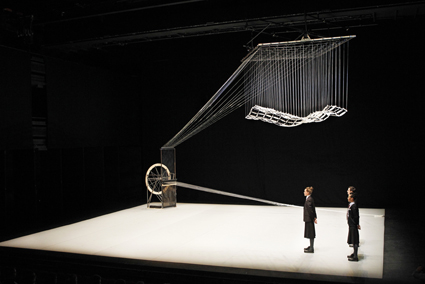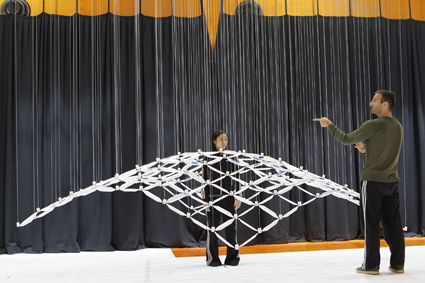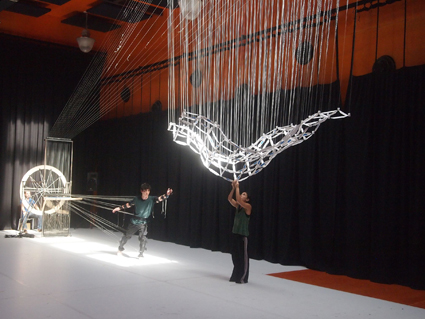kinetic art machine makes waves for dance
john bailey: reuben margolin & chunky move’s connected

Stephanie Lake, Harriet Ritchie, Joseph Simons, Connected, Chunky Move
photo Jeff Busby
Stephanie Lake, Harriet Ritchie, Joseph Simons, Connected, Chunky Move
NOT SO MANY YEARS AGO, REUBEN MARGOLIN MET A MAN IN SWITZERLAND OBSESSED WITH JIGSAW PUZZLES. THE MAN LIVES IN A MANSION WHERE MORE THAN A DOZEN ROOMS ARE FILLED WITH THE THINGS. THOUSANDS OF PUZZLES—OF DIFFERENT TIME PERIODS AND GENRES, SOME SELF-MADE. HE TOLD MARGOLIN THAT IN HIS VIEW, EVERYTHING IS A JIGSAW PUZZLE. EVERYTHING FITS WITH SOMETHING ELSE. NO, SAID MARGOLIN. EVERYTHING IS A WAVE.
At that point, says Margolin, “it occurred to me that whatever you’re really into, you start to see that everywhere. So the more I’ve gotten into waves, the more I see patterns everywhere.”
Waves are Margolin’s world. From his studio in Emeryville, California, the 40-year-old creates intricate kinetic sculptures that employ thousands of moving parts to embody the waves that occur across the natural realm. He visited Melbourne recently to deliver the sculpture he’s devised for Chunky Move’s Connected, a work which will see dancers harnessed into one of the artist’s complex moving wave-machines.
It’s hard to spend much time in Margolin’s company without finding yourself subtly affected by this notion of waves. “Anything that cycles can be expressed as a wave, and everything cycles. Everything goes around and around. The best way to describe something that cycles is a wave.”
He points to a door and calls it a wave. I have no idea what he means. “It opens and shuts, it opens and shuts,” he says. “But it opens and shuts more in the daytime and less at night. If you plotted that, the best way to understand that door opening and shutting is as a wave-form.”

Marnie Palomares, Gideon Obarzanek, Connected in rehearsal
photo Jeff Busby
Marnie Palomares, Gideon Obarzanek, Connected in rehearsal
The path that has led Margolin to where he is today would seem anything but wave-like: he enjoyed the challenges of geometry in high school and began studying maths at college. In his second year he switched majors to geology (“because I wanted to go camping”). The following year he changed focus again, to anthropology; finally, deciding he wanted to be a poet, he graduated in English. Not long after, he studied classical painting in Italy and Russia.
And yet, Margolin says, he was always making kinetic art. At eight he would craft little duck puppets and marionettes and try to sell them at craft fairs. “I’ve always liked making things. I keep coming back to the fact that I like cutting a piece of wood with a handsaw. That’s about as good as it gets. There’s nothing more grounding than having a two-by-four on a sawhorse and just cutting. It’s great.”
While still pursuing a possible career in painting, Margolin became obsessed with a caterpillar. The unique undulations of the creature fascinated him, and he wondered how they could be reproduced. He ended up spending five months devising a small mechanical sculpture inspired by the caterpillar; he’s now made three different versions, but says that he still hasn’t quite nailed it. “I think I will. Maybe I’m still working on it. Maybe every sculpture still has a little bit of caterpillar in it.”

Josh Mu, Marnie Palomares, Connected
photo Reuben Margolin
Josh Mu, Marnie Palomares, Connected
Margolin met Chunky Move’s Gideon Obarzanek at a PopTech conference in Maine in 2009. Impressed by the choreographer’s presentation of previous works exploring the intersection of technology and dance, the sculptor approached him and suggested a collaboration. “I was actually thinking of a very small weekend adventure with some strings and sticks but Gideon kept pushing it and we kept working together and it grew to be a much more ambitious, world-touring production.”
Connected is a departure from Chunky Move’s more recent high-tech projects due to the mechanical materiality of its sculptural centrepiece. Margolin’s wire-and-string creations don’t engage with the ethereal invisibility of electronics. Apart from the occasional motor, the forces that produce his waves are simple physics.
“I’m just sort of low-tech. It’s what I’m good at. Making small bits. It’s just fun to do. I feel like more and more as a culture we’re moving towards things that are digital. If you can do something not digital that is beautiful and elegant, to me that’s just super interesting.”
It’s important that the operative mechanisms of Margolin’s sculptures are on full display, too: “One thing that’s always been important for me is not to put a box around it. And not even to have a big plane that blocks your vision of how it works. Making it as transparent as possible. So it’s all there. You can see exactly how it’s working. But it’s complicated enough and there are enough parts that it becomes something else, hopefully.”
With much digital art—including Chunky Move’s acclaimed Glow and Mortal Engine—a sense of wonder is produced by the mystery behind the technologies creating what we see. Margolin’s sculptures operate differently. There’s no mystery. We can see everything. And yet the sheer number of moving components is what exceeds our capacity to understand what we’re being offered. “Nature is just so wonderfully fluid. You see waves that are perfectly formed and variable and magnificent in water and wind and flames and trees. Everywhere. The only way to kind of go in that direction is to throw a lot of little parts at it.”
Margolin’s exploration of waves has also resulted, perhaps organically, in a broader philosophical view of the patterns of life. “I think that having studied the wave I have a little bit more tolerance than most people that there’s going to be some good times and there’s going to be some bad times. There’s going to be times when I have no money and times when I have money. Times where I’m really happy with what I’m doing and times where I’m not.
“Because these things that I study, waves, are everywhere, and they also have their ups and downs, that is going to happen with mood, with relationships, with politics. I feel more tolerant when things aren’t going well; that’s okay, I’m down, but I’ll probably go back up. And later, hey, I’m up here, but will probably go back down again.”
And yet, surely, the counterpoint to the wave is the interruption, the shock that breaks any cycle? Margolin demurs: “If you had what you’re calling a large shock or rupture, what if you had another one the next day? And another the next day? You’re looking at one peak or one valley, and you just need to relate that to all those peaks and valleys of that amplitude, that scale, and there’s another wave that’s in there. I’m not sure that there are these giant, discontinuous events, or whether they only look discontinuous because you’re not far enough away to see them as a larger pattern.”
–
Dance Massive, Chunky Move, Connected, Malthouse, Melbourne, March 15-20; www.dancemassive.com.au
RealTime issue #102 April-May 2011






